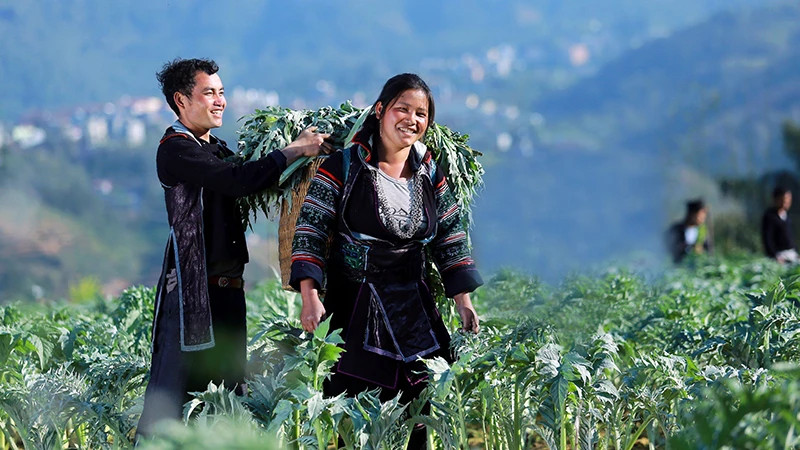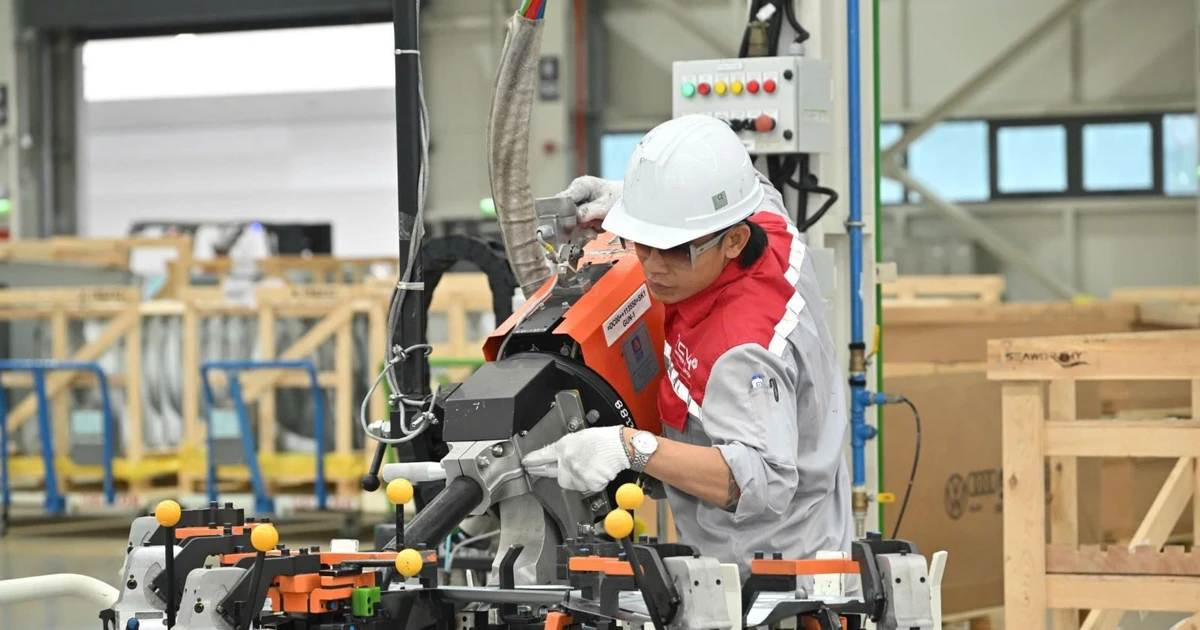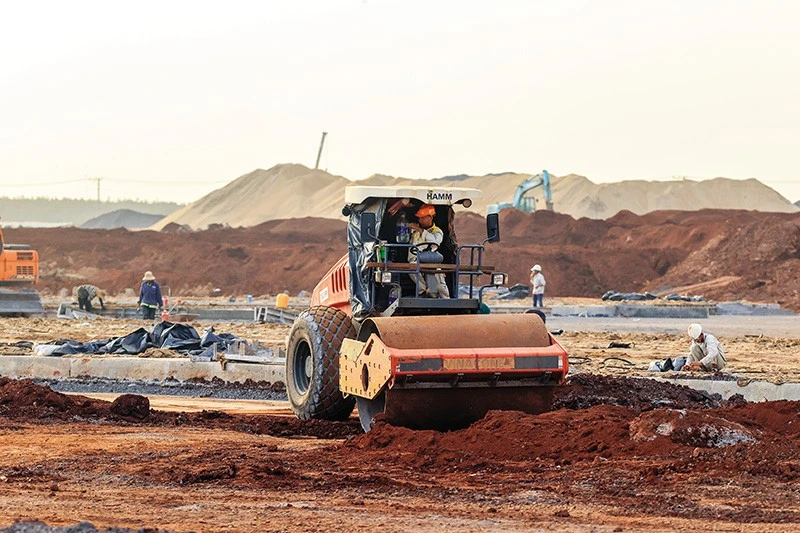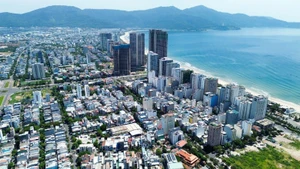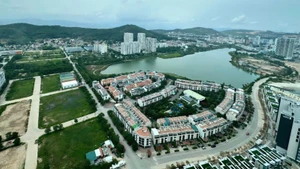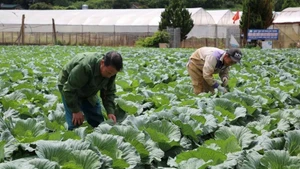The total area for growing medicinal plants in Vietnam is 357,178 hectares, of which the area planted on land planned for forestry, planted under the forest canopy is 220,178 hectares. And those planted on agricultural land, both perennial and short-term plants are 137,000 hectares with the total number of medicinal plant species grown being 150 different species.
Escaping poverty thanks to medicinal plants
When proposing to introduce some medicinal plant growing models in the area, the Head of the Department of Agriculture of Ba Che District, Quang Ninh Province Vi Thanh Vinh took us to visit some households and cooperatives growing medicinal plants. It was a hot summer afternoon in July, but the scorching sun was somewhat less harsh when we stepped into the green medicinal plant carpets.
To go deep into the medicinal plant growing areas, we had to walk a stretch of dirt road, after the rain the day before, the road was still not completely dry, the soil was thick and sticky with the smell of mud, under the scorching sun, creating a strong, characteristic smell of soil.
Chairman of the People's Committee of Ba Che District Do Manh Hung shared that Ba Che has many precious medicinal plants, the most prominent is Morinda officinalis and in the past 20 years, yellow flower tea. Previously, people mainly planted acacia trees, however, this type of tree took five to seven years to harvest, causing many difficulties for households' economies. Thanks to orientation and conversion, most people here have now switched to growing medicinal plants.
Medicinal plants can be harvested after only a short time of planting, helping households have a steady income and gradually eliminate poverty sustainably. People here have planted hundreds of thousands of Morinda officinalis and yellow camellia trees and continue to plant dozens of hectares of cinnamon in the near future, helping people here significantly eliminate hunger and reduce poverty. According to the plan, in the 2021-2025 period, Ba Che District will plant 517 hectares of new medicinal plants.
Mr. Hoang Xuan Thach’s family from Lang Mo Village, Don Dac Commune, Ba Che District has nearly two hectares of yellow camellia that have been planted for nearly 20 years. Previously, Mr. Thach’s family was a poor household, when Ba Che District launched the movement to grow yellow tea flowers, they were one of the first families to participate in that movement. Income from yellow tea flowers has helped the family to eliminate hunger, reduce poverty, and stably increase income.
Not only in Ba Che, the Northwest region is being oriented to become a large-scale medicinal herb growing area and Lai Chau, Dien Bien, Son La, Ha Giang, and Lao Cai, are places with many precious and rare medicinal herbs. Currently, about 50 medicinal plant species are grown on large areas (more than 10 hectares), of which the Northwest alone has 36 species, such as angelica, platycodon, purple cardamom, cardamom, artichoke, coix seed, star anise, cinnamon, and ginseng.
According to the leaders of some localities, artichoke and ginseng are plants that make many families rich. Each hectare of artichoke in a crop can earn approximately 100 million VND in profit from the leaves alone. If harvesting the stems, tubers, and flowers, one hectare can earn up to nearly 200 million VND. Each hectare of Polyscias fruticosa yields an income of 250 to 300 million VND/year, the roots alone yield an income of about 200 million VND.
Morning Glory, a medicinal plant is gradually asserting its position in the midland region due to its higher efficiency than growing other food crops and flowers, each hectare of Morning Glory yields an income of 80 to 160 million VND/year. In the area where bitter ground vegetables are harvested, people's income is improved each harvest (from April to October), on average, a person has an additional income of 2 to 3 million VND/month.
A Luoi has the most difficult socio-economic conditions in Thua Thien Hue Province, but it has a cool and fresh climate, suitable for growing medicinal plants. The precious medicinal plant growing area project is implemented on an area of 363.4 hectares in the communes of Quang Nham, A Roang and Hong Bac, with medicinal plants: Morinda officinalis, Bach Ho, Solanum procumbens, Artichoke, Polyscias fruticosa, Polygonum multiflorum, Dioscorea, Ophiopogon japonicus, Purple cardamom, Panax pseudoginseng, Millenium nigrum and Black-bone.
Nam Tra My District, Quang Nam Province has implemented a project to preserve and develop medicinal plants in the area in conjunction with the local poverty reduction task. The project is based on the form of the State and the people working together, in which, the district supports and mobilises maximum resources of the people to develop medicinal plants into commodity production, organises training for service teams to serve production, purchasing, processing, packaging, displaying, introducing and promoting. Based on medicinal plants, many poor households have risen to become well-off households, creating sustainable livelihoods for the people.
The total export value of Vietnamese medicinal herbs is estimated at 400 million USD/year, of which the main contributors are cinnamon, star anise and cardamom. Moving forward, the medicinal herbs industry can export higher-value medicinal herbs such as Morinda officinalis, yellow tea, artichoke, and Solanum procumbens.
 |
| Head of the Department of Agriculture of Ba Che District (Quang Ninh) Vi Thanh Vinh talks with a family growing yellow tea. (Photo: Thanh Mai) |
Building a closer linkage
According to the Deputy Director of the Department of Traditional Medicine Management under the Ministry of Health Tran Minh Ngoc, Vietnam is assessed to have great potential for developing medicinal herbs with more than 5,000 medicinal herb species, including many precious and rare species and traditional ethnic medical knowledge with many valuable remedies, which is a priceless treasure to create products from medicinal herbs including medicinal herbs, traditional medicines, health care products.
Every year, the total amount of medicinal herbs used in the medical sector in Vietnam is estimated at 100 thousand tonnes. The use of medicines and products from medicinal herbs is also a trend in today's world. However, the reality in many regions, is that harvesting and exploitation do not go hand in hand with conservation. Most of the planting and processing of medicinal herbs is on a small scale, at the household level. The supply of medicinal plant seeds is still limited, often bought by traders at high prices but the quality and origin are unclear. Growers mainly rely on experience, the lack of investment from pharmaceutical enterprises in the production and consumption chain of medicinal herbs makes the economic efficiency for people and medicinal plant growers not high.
Looking at the localities, it can be seen that most medicinal plants have not been processed into active ingredients but are mainly sold as raw materials, so the value is not commensurate. To promote strengths, it is necessary to have appropriate exploitation and development mechanisms and policies, especially attracting the participation of enterprises and scientists in processing raw medicinal herbs into pharmaceutical products.
In addition, solving the output problem for medicinal herbs by developing a model: Combining traditional medicine and medicinal herbs; Using medicinal herbs to create products for treatment, health care, and green tourism. To solve this situation, localities need to soon develop a plan for medicinal herbs areas, turning this resource into a potential, key advantage to promote socio-economic development, and build a closer linkage among relevant parties.
Policies to encourage the production and trading of medicinal herbs, and to preserve and limit harmful human impacts on areas containing many precious and rare medicinal herbs. More participation from scientists is needed, from transferring science and technology in breeding, planting, caring, and harvesting, to processing and extracting medicinal herbs. On the business side, it is consumption and capital support.
Farmers produce according to technical standards to ensure product quality. With the viewpoint of “Cooperation creates superior strength”, businesses, scientists, and farmers need to link up into a network, becoming partners in all activities of the four stages: product research, development, manufacturing and distribution on the market.
